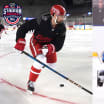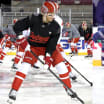The Coaches Room is a regular feature throughout the 2023-24 season by former NHL coaches and assistants who turn their critical gaze to the game and explain it through the lens of a teacher.
In this edition, Davis Payne, former coach of the St. Louis Blues and assistant with the Los Angeles Kings, Buffalo Sabres and Ottawa Senators, breaks down the Eastern Conference Final between the New York Rangers and the Florida Panthers and looks ahead to Game 4 at Florida on Tuesday.
The Eastern Conference Final between the New York Rangers and the Florida Panthers has been a tight, hard-fought series so far. New York leads the best of-7 series 2-1 with Game 4 coming up at Florida on Tuesday (8 p.m. ET; ESPN+, ESPN, SN, TVAS, CBC).
After Florida won 3-0 in Game 1 and physically sort of shoved New York onto its heels, the Rangers responded in a 2-1 overtime win in Game 2 with more physical play from everybody, not just their physical players.
Then, the Rangers found a way to win 5-4 in overtime in Game 3 on Sunday, despite being outshot 37-23 and the Panthers having a 108-43 advantage in shot attempts. I think if you break it down just based on shot volume and zone time and shot attempts, you would say that Rangers goalie Igor Shesterkin was the star of the game.
That’s certainly a way to win a game in the Stanley Cup Playoffs, but over time that volume is something that New York has got to be aware of.
If you look at Florida’s team, you get hit every time you touch the puck. I think it took New York a little bit of time to get comfortable with that -- one game, maybe one-plus. In Game 3, I thought New York matched that physicality for the first 25-30 minutes, but the playoffs often are a lot about how long you can stay with your game.
Getting comfortable knowing that Florida’s not backing off is something New York is going to have to be prepared for because Game 4 is going to be every bit of that and then some.
That being said, the Rangers have done a good job of possessing the puck and taking the plays and making the plays that are available to them. It’s not like they’re hanging their goaltender out to dry or giving up crazy A-plus chances. It’s just a matter of is volume going to beat you versus the precision or are you going to be able to sort of even that up?
The Panthers are one of the best forechecking teams in the League. It’s their M.O. They don’t want to mess around in the neutral zone. They just want to get it behind you and start banging and going to work.
New York would rather possess the puck, and that’s fine. It’s sort of what you’re built towards, but as series move along, that wear and tear from being forechecked really starts to add up.
That was our M.O. with the Los Angeles Kings when we won the Stanley Cup in 2012 and 2014. We knew that if we didn’t get you in Games 1-4, we’re going to get you in Games 5-7 because you’re not going to withstand that physical pounding time after time after time.
Once the territory gets evened out, then it becomes which player makes the right, hard play. You can see some of the depth on the Rangers has stepped up beyond the depth of the Panthers with Barclay Goodrow and Alex Wennberg scoring big goals. That’s probably why the Rangers lead the series.























